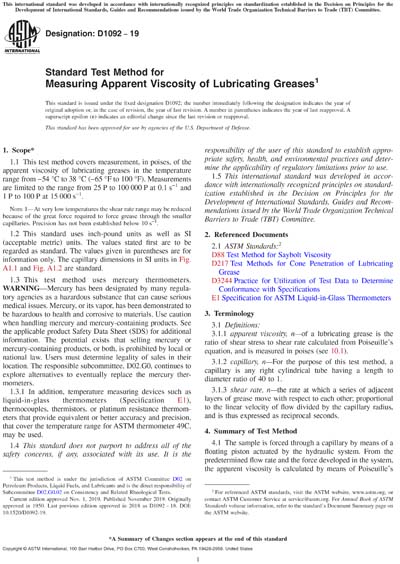Historical
ASTM D1092-19
Standard Test Method for Measuring Apparent Viscosity of Lubricating Greases
1.1 This test method covers measurement, in poises, of the apparent viscosity of lubricating greases in the temperature range from −54 °C to 38 °C (−65 °F to 100 °F). Measurements are limited to the range from 25 P to 100 000 P at 0.1 s−1 and 1 P to 100 P at 15 000 s−1.
Note 1: At very low temperatures the shear rate range may be reduced because of the great force required to force grease through the smaller capillaries. Precision has not been established below 10 s−1.
1.2 This standard uses inch-pound units as well as SI (acceptable metric) units. The values stated first are to be regarded as standard. The values given in parentheses are for information only. The capillary dimensions in SI units in Fig. A1.1 and Fig. A1.2 are standard.
1.3 This test method uses mercury thermometers. WARNING—Mercury has been designated by many regulatory agencies as a hazardous substance that can cause serious medical issues. Mercury, or its vapor, has been demonstrated to be hazardous to health and corrosive to materials. Use caution when handling mercury and mercury-containing products. See the applicable product Safety Data Sheet (SDS) for additional information. The potential exists that selling mercury or mercury-containing products, or both, is prohibited by local or national law. Users must determine legality of sales in their location. The responsible subcommittee, D02.G0, continues to explore alternatives to eventually replace the mercury thermometers.
1.3.1 In addition, temperature measuring devices such as liquid-in-glass thermometers (Specification E1), thermocouples, thermistors, or platinum resistance thermometers that provide equivalent or better accuracy and precision, that cover the temperature range for ASTM thermometer 49C, may be used.
1.4 This standard does not purport to address all of the safety concerns, if any, associated with its use. It is the responsibility of the user of this standard to establish appropriate safety, health, and environmental practices and determine the applicability of regulatory limitations prior to use.
1.5 This international standard was developed in accordance with internationally recognized principles on standardization established in the Decision on Principles for the Development of International Standards, Guides and Recommendations issued by the World Trade Organization Technical Barriers to Trade (TBT) Committee.
Content Provider
ASTM International [astm]






